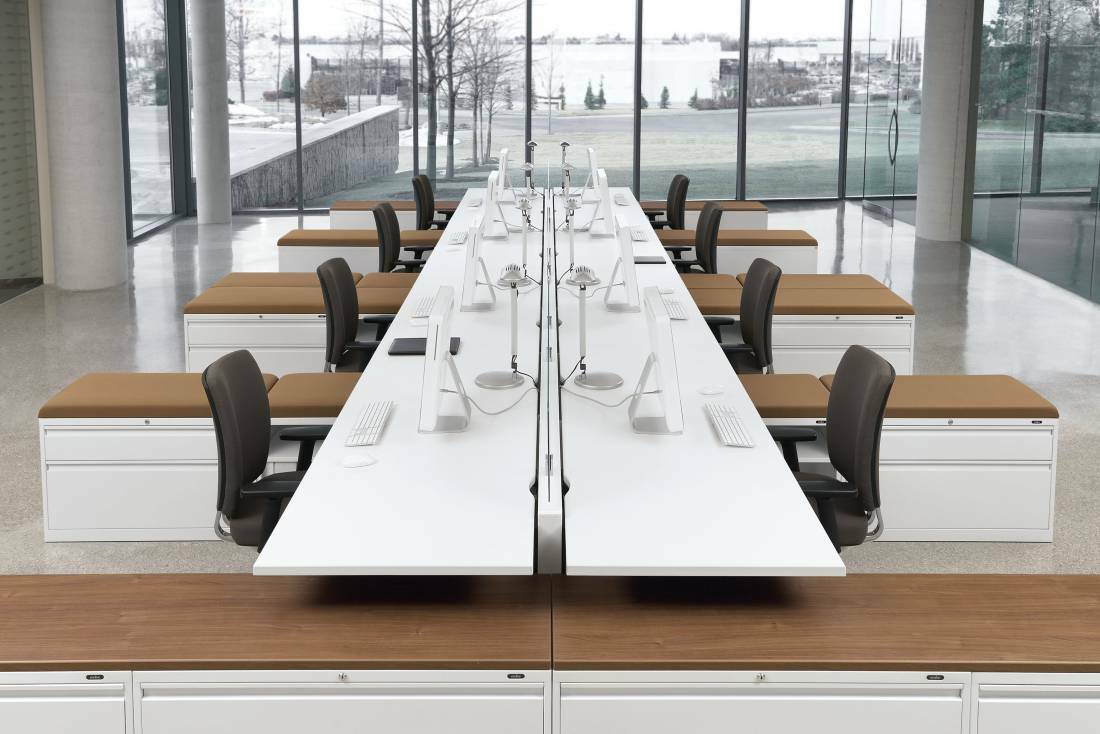The rise of the hybrid work model: Returning to the office after COVID-19
Subscribe
Join us as we explore industry trends, best practices, and highlight stunning office transformations.
COVID-19 created a worldwide work-from-home experiment, but as it becomes safer for employees to return to the office, many employers are insisting people return to the office full-time. Others are creating a hybrid work environment, while some have decided to stay remote indefinitely. But what do employees really want?
Navigating the journey of returning to the workplace is stressful for both employers and employees. As you decide your organization's future, you’ll need to understand the future of the corporate office as it stands today, what’s best for your employees, and if you need to make any changes to your office space.
The future of the corporate office
The debate we hear most often is whether the corporate workplace will remain completely hybrid or whether employees will be in the office full-time.
Employees are challenging the idea of a traditional work environment—long commutes, 9-5 days, and missing out on the important things of life are a thing of the past.
Approximately 56% of full-time employees in the United States—more than 70 million workers—say their job can be done working remotely from home. That means more than half of America doesn’t want to return to the office full-time.
In short, the future of the corporate office model is hybrid. Whether employees come in once a week or 3 times a week, the hybrid office model is rapidly gaining popularity and is expected to continue to do so well into the future.
The benefits of a hybrid work environment
Despite the success of the great work-from-home model, employers are still unsure if remote work is best for their employees and the organization as a whole. But there are several benefits to a hybrid model.
Here are the top 5 benefits of implementing a hybrid work model:
Improved work-life balance: Eliminating a commute can save employees more than 6 hours a week spent just getting to and from work. A better work-life balance improves employee satisfaction and well-being.
Decreased levels of stress and burnout: 7 in 10 employees feel burned out in 2022. A hybrid model enables employees to balance their work and life in a way that works for them, leading to less burnout and improving mental well-being.
Higher productivity and efficiency: A hybrid model offers employees far more flexibility allowing them to work more efficiently. Employees have flexibility in where they work and are more likely to balance their workload for optimal productivity.
Increased collaboration: One of the top concerns of remote work is employee collaboration, but in reality, remote work makes collaboration easier than ever. Employees no longer need to be in the same room at one time to work together, they simply need an internet connection.
Top recruitment tool: Top employees desire the flexibility that a hybrid work model offers. To recruit the best employees and retain them, your organization needs to provide top-tier benefits.
Despite concerts, it seems as though hybrid work is the best of both worlds for employers and employees alike.
Should you renovate your office post-covid?
COVID-19 has completely redefined the workplace, so you will most likely need to make some changes to your office layout.
Employee collaboration and team engagement have always been a priority, which is how the open floor plan was born. With no walls and doors to separate employees, the open floor plan concept became extremely popular in the corporate world.
So is the open floor plan idea gone? Not necessarily; it just needs a few adjustments.
Today’s employees need more privacy than most open workspaces offer. Our featured brands, like Global Furniture Group offer workstations complete with acoustic panels and glass stackers to reduce sound levels and define work areas. Designated workstations are often the perfect addition to a corporate office because they provide the privacy your employees' desire without sacrificing collaboration.

As you decide how best to renovate your office, prioritize implementing defined focused spots and collaborative spaces. Build a ‘third place’ where employees can come together and build on their relationships. These areas foster a greater sense of community—something that employers felt have lacked since the outbreak of COVID-19.
It’s vital to create an environment that can cater to employees that are in the office and remote at the same time. This way, collaboration doesn’t have to stop because an employee isn’t in person.
Aside from the layout of the office, you will need to renovate your space to meet current health and safety protocols. Consider implementing things like:
Furniture and surfaces that can easily be sanitized and cleaned
Ergonomic furniture to provide your employees with ultimate comfort throughout the day
Sending a survey to your employees to see what measures they would like to see done
It boils down to one thing: Trust
The biggest thing to remember when deciding to install a hybrid-work model is trusting your employees—and it goes both ways. Employees must trust that they need to come back to the office for a reason and employers need to trust employees that work will get done no matter where they are.
The proof is in the data, but the truth is that not all employees excel in a remote environment. Keep a close eye on productivity levels to ensure that your employees excel and your organization thrives.
If you’re looking for a trusted professional to transform your corporate office layout, get in touch with our team at Furngully.
